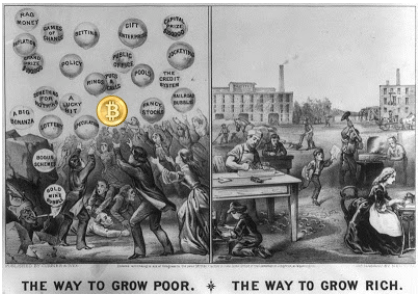
Cross-posted from Bullion Barron
Bitcoins have been making headlines on mainstream news sites, on blogs and even on precious metal forums recently and with good reason given the vertical rise in price per Bitcoin:
 |
| Bitcoin: Market Price (USD) |
But is this rise part of a bubble or a new paradigm for virtual currencies as their utility increases and becomes more mainstream?
There is a lot of speculation that the Bitcoin mania has been a result of the recent Cyrpus crisis, however much of this speculation was due to an increase in app downloads in a single country where iPhones do not have a large market share:
This was spotted by BGR writer Tero Kuittinen, who noted that three iOS apps — Bitcoin Gold, Bitcoin Ticker and Bitcoin App — each jumped up the App Store charts in Spain, all on the same day, as the news broke from Cyprus. Compare their download histories to those from a country like the UK and it’s clear that the upward trend is more pronounced in the more at-risk nation. Bitcoin Gold’s all-time high ranking of 83 in Spain came on 17 March; for Bitcoin Ticker, 68 on 17 March; Bitcoin App reached a high of 147 on 19 March. The highest rankings for those apps in the UK are lower — 293, 201 and 48 — and they were all records set months or even years ago. Indeed, there hasn’t been any kind of correlation between the Cyprus news and an uptick in Bitcoin app interest in the UK, going from this.The huge caveat to this, though, is that the iPhone’s market share in Spain is tiny, at roughly four percent of the total smartphone market as of mid-2012. Only a percentage of people who trade Bitcoins will trade or keep up to date with prices on their smartphones, too. A spike in iOS app downloads in one Eurozone country is a terribly small sample from which to draw conclusions about whether the Eurozone crisis is driving more people across the continent to Bitcoins. Wired
It seems more likely to me that the increase in Bitcoin app activity was a result of the surge in Bitcoin price that had recently taken the price to all new highs by the 17th of March, the further rally which took the price to levels above US$50 (which probably sparked even more interest) & the crash that had occurred several days earlier due to a glitch in the blocks/programming.
 |
| Click to Enlarge: Timeline of Events, 2 Months |
With this number of events all occurring in unison, it’s not hard to see there were other reasons for the increase in Bitcoin activity, other than finding a safe haven currency to avoid depositor haircuts as some have speculated was the case.
For those who are not familiar with Bitcoins, they are a virtual currency. First created in 2009, they can be transacted peer to peer and through exchanges such as the most popular Mt.Gox. Their creation is not controlled by a central authority, their supply is expanded with the use of a mathematical algorithm.
The price of a Bitcoin has risen from around US$10 to over US$70 in the space of 4 months. Some might call that a bubble with little more thought given, but scratch under the surface of the price and there could be valid reasons for the increase in price.
One of the reasons for the large rise in price is a combination of a slowing number of them being added to circulation:
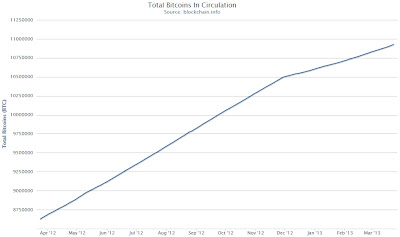 |
| Bitcoin: Total Bitcoins in Circulation |
Starting from 2009 the number of Bitcoins generated every 10 minutes was roughly 50, every 210,000 generations (approximately 4 years) the creation rate drops in half (50, 25, 12.5, etc), the number of Bitcoins in circulation will never number more than 21 million:
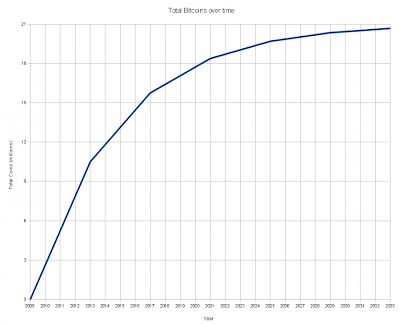 |
| Total Bitcoins Over Time |
As is evident from the above charts, the first halving of Bitcoin inflation has taken place toward the end of 2012, near the recent price lows and start of the rally which culminated in the parabolic spike. Plenty of speculation on what would happen (including expectations of a rising price) was taking place last year:
The implications to this are huge and for the most part unknowable. There are two ways I can see it going;-– Mining is a delicate balance of difficulty vs electricity costs, the price of bitcoin depends on the electricity cost to generate those coins so if the cost to generate a bitcoin increases the price of a bitcoin rises to match.
People stop mining bitcoin because the cost outweighs the return and the difficulty of generating a bitcoin (currently at 3368767) plummets until it is once again profitable to mine.
I believe that it will be a mix of both, I think the price will rise and the difficulty will drop but that is just me speculating. The truth is we are in for an interesting time, I don’t even want to factor in the new bitcoin mining hardware (ASIC) that seem to be about to hit the market. MineForeman
Can the halving of creation rate alone justify a 7x rise in the price of Bitcoins? Probably not by itself.
Along with the halving of creation rate, we’ve also seen the number of transactions and unique addresses used for transactions rise (together these numbers indicate an increasing number of people using Bitcoin rather than increase in number of addresses used per person):
 |
| Bitcoin: Number of Transactions Per Day |
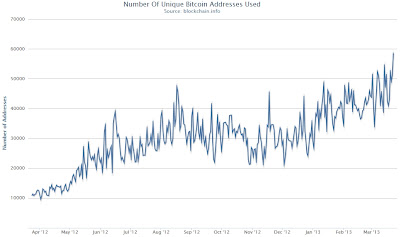 |
| Bitcoin: Number of Unique Bitcoin Addresses Used |
An increased number of people using Bitcoin has resulted in a “network effect” where it’s value has risen as demand increases:
In economics and business, a network effect (also called network externality or demand-side economies of scale) is the effect that one user of a good or service has on the value of that product to other people. When network effect is present, the value of a product or service is dependent on the number of others using it.The classic example is the telephone. The more people own telephones, the more valuable the telephone is to each owner. This creates a positive externality because a user may purchase a telephone without intending to create value for other users, but does so in any case. Online social networks work in the same way, with sites like Twitter, Facebook, and Google+ becoming more useful as more users join.
The expression “network effect” is applied most commonly to positive network externalities as in the case of the telephone. Negative network externalities can also occur, where more users make a product less valuable, but are more commonly referred to as “congestion” (as in traffic congestion or network congestion).
Over time, positive network effects can create a bandwagon effect as the network becomes more valuable and more people join, in a positive feedback loop. Wikipedia
The network effect can very much apply to currencies, especially so where the Government/central banks can’t increase the number of currency units to meet demand, so Gold has also benefited from the network effect over the bull market as an increasing number of people want to own it, but where there is no easy way to increase the amount (while Gold doesn’t have a known limit like Bitcoin, there are other reasons we can’t dig more up on a whim including declining grades available to mine).
Despite the positives for Bitcoin, there are still risks which have the potential to impact on price.
ASIC(s) – Application Specific Integrated Circuits are essentially specialised computer chips designed for mining Bitcoins in the most efficient way possible. To date much of the Bitcoin mining that occurs has been via powerful computers which also have a high running cost (e.g. gaming rigs with specific graphics cards which lend themselves to the process), but with these new systems comes lower entry& running costs which will result in more competition… how much effect this will have on the price of Bitcoins is yet to be seen as consumer ASICs have only started shipping early this year (read more here). They could have a dampening effect on the price in the short term (lower cost to mine), but then as they become more common the competition will force a reduction in the profits for the early adopters, driving the cost to mine higher again.
Regulation – Recent news out of the US includes threats of regulation of the BitCoin market:
The U.S. is applying money-laundering rules to “virtual currencies,” amid growing concern that new forms of cash bought on the Internet are being used to fund illicit activities.The move means that firms that issue or exchange the increasingly popular online cash will now be regulated in a similar manner as traditional money-order providers such as Western Union Co. WU +1.04% They would have new bookkeeping requirements and mandatory reporting for transactions of more than $10,000.
Moreover, firms that receive legal tender in exchange for online currencies or anyone conducting a transaction on someone else’s behalf would be subject to new scrutiny, said proponents of Internet currencies. Wall Street Journal
As transacting the currency can occur peer to peer, there is little any one Government could do to stamp out use, however if the large exchanges (where currency for Bitcoin swaps take place) were targeted, there is the potential for it to have a negative effect on the ease of use and market for Bitcoins.
Hacking – The most obvious risk to a virtual currency is the risk of storing them. Hold them on your local computer and they are at risk if you accidentally delete them or your hard drive crashes. There is also the potential someone could hack into your computer and transfer them out if you haven’t stored them securely enough. The problem is that all transactions are irreversible and difficult to trace, so once they are gone it’s unlikely you will see them again. Not only are criminals targeting individuals who hold Bitcoins, but also exchanges and sites offering online stored wallets/Bitcoins. As the value of Bitcoins increases so will the sophistication and efforts of criminals to steal them. It was a hacked exchange which resulted in the 2011 crash in price (from a peak just above US$30):
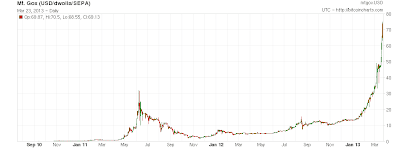 |
| Click to Enlarge: Bitcoin Chart Showing 2011 Crash and Today’s Boom |
The Bitcoin community faced another crisis on Sunday afternoon as the price of the currency on the most popular exchange, Mt.Gox, fell from $17 to pennies in a matter of minutes. Trading was quickly suspended and visitors to the home page were redirected to a statement blaming the crash on a compromised user account. Mt.Gox’s Mark Karpeles said that the exchange would be taken offline to give administrators time to roll back the suspect transactions.The extent of the compromise became clear when a copy of Mt.Gox’s user database began circulating online. The file included username, email addres, and hashed password for thousands of Mt.Gox users. Karpeles’s statement was updated to acknowledge the breach. He warned users who have re-used the Mt.Gox passwords on other sites to change them. Ars Technica
The increase in value of Bitcoins (market capitalisation of all Bitcoins rose from just over $100m to almost $800m with the recent price rise) is likely to paint a larger target on the Bitcoin exchanges and people with a large number of Bitcoins in their virtual wallets. Who knows what sort of exchange hacks or malicious code could end up affecting the Bitcoin market in a negative way.
So all this said, with rational reasons for an increase in price (although perhaps not to the extent it has) is the Bullion Baron about to run out and purchase some Bitcoins and hope their utility and in turn value continues to increase? Not likely. The main problem I see for the investor/speculator (see this post for my definitions) is that there is no accurate way to value the Bitcoin and while precious metals are much the same, there are several key differences:
- Precious metals are a physical commodity, Bitcoins are a virtual currency.
- Precious metals have history spanning thousands of years as money and a store of value, Bitcoins have a few short & volatile years as a virtual currency.
- Precious metals have utility outside of monetary use (industrial, jewellery, etc), Bitcoins are only useful as a currency used in transactions.
- Precious metals are more easily purchased (at least that is the case in Australia, from my experience).
- Precious metals have a history of cycling in value against other assets such as oil, stocks & land, Bitcoins have no such history.
They do also have some similarities:<
- Neither have a governing body/central authority that can produce them in unlimited quantities.
- They are both a limited resource (Gold by it’s natural occurrence in the earths crust and Bitcoins by the algorithm which controls the number created).
- Both will be harder and more expensive to mine over time (Gold due to decreasing grades and rising input costs, Bitcoins due to increased competition, technology advances and the reducing number created until peak 21m reached).
- Precious metals and Bitcoins are both seen as a threat to official currencies and are likely to see action as a result (more regulation).
There is no reason to expect that Bitcoins will act as a store of value over the long term, but then if their popularity continues to increase then likely so will their price over the long term. The number of sites and services that can be used with Bitcoins is increasing regularly, there is quite an extensive list here: Spend Bitcoins and there has even been news of Bitcoin ATMs to make funding your account even easier:
Zach Harvey has an ambitious plan to accelerate adoption of the Internet’s favorite alternative currency: installing in thousands of bars, restaurants, and grocery stores ATMs that will let you buy Bitcoins anonymously.
It’s the opposite of a traditional automated teller that dispenses currency. Instead, these Bitcoin ATMs will accept dollar bills — using the same validation mechanism as vending machines — and instantly convert the amount to Bitcoins and deposit the result in your account. CNET
My gut tells me that at US$70 Bitcoins are probably closer to a short term bubble peak (given the short term nature of the rise) than at the base of an immediate move to $150 or other high price targets I have seen thrown around ($500+), but that doesn’t mean they can’t head higher (in the short or long term).I think to a degree the price in the short term will depend a lot on who is holding Bitcoins and for what purpose. If there are a lot of speculators or people storing large amounts with no reason to transact then a move to sell and take profit could drive the price lower. If there are few of these types though and the price is being driven higher by a genuine need for Bitcoins for use in transactions then the price could keep moving higher.
Personally though even if I thought Bitcoins were undervalued, after rising 700%, their risks and weaknesses would stop me from putting any significant amount of money into them, a couple of thousand dollars maybe for a punt, but nothing serious. Although they have similarities to precious metals, they are far from a replacement.

